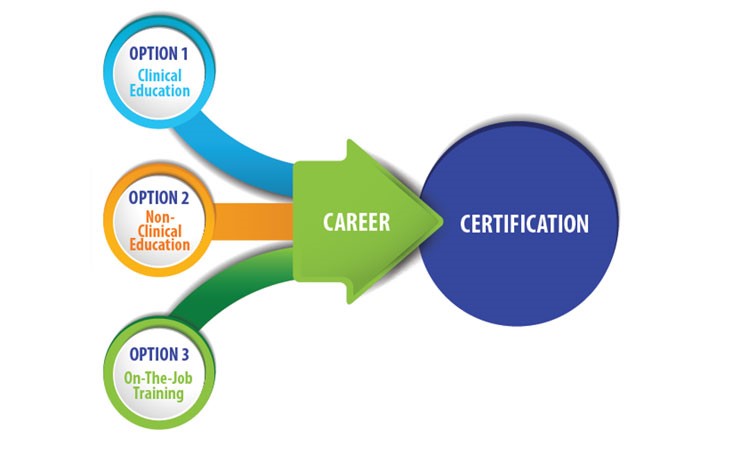This blog is the sixth in a series of profiles of different clinical health professions represented by Health Professions Network member organizations. These profiles are intended to give students and those looking at prospective careers in health care an accurate, professional perspective on different health care fields, specialties and careers. "A Day in the Life of an Ophthalmic Medical Technician" was developed by the International Joint Commission on Allied Health Personnel in Ophthamology, or IJCAHPO, an HPN member organization.
Table of Contents
- What is an Ophthalmic Medical Technician?
- Goals and Rewards of Being an Ophthalmic Medical Technician
- Becoming an Ophthalmic Medical Technician: Educational Programs
- Professional Outlook & Salary

What is an Ophthalmic Medical Technician?
Ophthalmic Medical Technicians are allied health care professionals in the field of ophthalmic medical assisting. Ophthalmology is the practice of medicine concerned with anatomy, diseases and treatments of the eye. Ophthalmic Medical Technicians (also called Allied Ophthalmic Personnel or AOP) work alongside eye doctors (Ophthalmologists) who provide medical and surgical treatment of eye conditions. Ophthalmic Medical Technicians play an important role in patient care and are a valuable part of the eye care team.
AOP take patient health histories, test vision, perform diagnostic examinations, administer eye medications, evaluate eye muscle movements and educate patients, as well as assist Ophthalmologists in surgical settings. They are trained to work with people who need glasses and contact lenses, and those who have a variety of eye disorders, such as cataracts, glaucoma and diabetic eye disease.
A key aspect of the value provided by AOPs is that in their role as “physician extenders,” they are the primary assisting team member for ophthalmologists, and their work allows ophthalmologists to see more patients in a day then would otherwise be possible. In this way, AOPs greatly increase the efficiency of care and patient access to necessary ophthalmology services.
Work environment
Ophthalmic Medical Technicians work alongside Ophthalmologists in private practices, medical centers, hospitals and university clinics. They see patients of all ages—from babies and children, to adults and the elderly. Most ophthalmic practices hire both part-time and full-time AOP. While many other health care professions may require you to be on-call and work long hours (including holidays), most ophthalmic practices’ work schedules are Monday to Friday, with very little weekend work. This provides a consistent work schedule (as compared to other healthcare professions, where individuals are expected to be on-call, often during nights and weekends), allows AOPs to have a predictable work-life balance.
- “In this field, you are always learning. I really enjoy the daily variety and career opportunities that this profession has offered me, and I take pride in my work.” -Valentina, COA
- “The most rewarding part of this profession to me is connecting with patients. I work in a retina clinic where we see a lot of blindness and fear, so being able to provide compassion to my patients is extremely rewarding.” - Stacie, COA
- “I have been in ophthalmology for 12 years. I work full-time for a very large and well-known hospital in my area and I could not be happier. I make a very good living, have great benefits, and love what I do. I am also preparing to take the Certified Ophthalmic Technician (COT) certification. I would never have dreamed that I would be where I am today.” - Colleen, COA

Goals and Rewards - What Makes the Career Special
Patient interaction/patient support
Patients schedule appointments to have their eyes examined, their vision corrected, or a problem diagnosed. Your professionalism and quality of care when they arrive and throughout their appointment will make a real difference in patients’ vision and more importantly, their lives. Due to the high degree of patient interaction, personality and demeanor are salient considerations for AOPs. Outgoing/extroverted, compassionate, empathetic individuals with good communication skills tend to experience greater success in this role.
Contribution to quality/health system
Ophthalmology is leading the way in fascinating technologies to cure diseases like glaucoma, cataracts, and blindness. You will be on the forefront of this new wave of technology and treatment. Additionally, as part of an AOP’s responsibilities is the education of patients regarding their ophthalmic treatment, AOPs contribute greatly to patients’ self-advocacy, which provides significant public health benefit.
Personal & professional goals and expectations
- “I am currently a Certified Ophthalmic Technician (COT) and am interested in taking next steps to become a Certified Ophthalmic Medical Technologist (COMT). I believe anyone who is willing, driven, and passionate about their work could excel in the field of ophthalmology.” - Brenda, COT
- “If you are looking for a career that helps to make a difference in people’s lives, offers professional growth, the ability to take care of your family, have a regular schedule, and so much more, become an Ophthalmic Assistant!” - Carlos, COA

Becoming an Ophthalmic Medical Technician
Academic requirements
To enter the field, you will need a minimum of a high school diploma, GED or equivalent. There are two pathways to start your ophthalmic assisting career:
1. Attend an accredited academic educational program.
Contact your local program and ask questions about the length of the program, how to apply and when you can get started. It is always a good idea to take a tour to understand how the program will fit your needs. View the list of accredited training programs
Typically, educational curriculum and coursework will cover:
- General and ocular anatomy and physiology
- Medical terminology
- Medical laws and ethics
- Ophthalmic optics
- Microbiology
- Ophthalmic pharmacology
- Ocular motility
- Diseases of the eye
OR — 2. Gain the necessary skills through on-the-job training work experience.
Earn while you learn! Find a local employer who will provide supervised entry-level work experience. View available job opportunities
Most ophthalmic practices have some form of on-the-job training available for entry level employees. However, there is also the possibility that ophthalmic medical assistants can pursue independent study before sitting for the certification examination as well.
Clinical requirements
The International Joint Commission on Allied Health Personnel in Ophthalmology (IJCAHPO) offers three levels of core certification:
- Certified Ophthalmic Assistant (COA)
- Certified Ophthalmic Technician (COT)
- Certified Ophthalmic Medical Technologist (COMT)
The options below will prepare you for certification through IJCAHPO. Choose the path that best fits your needs and learning style.

Option 1: Clinical Education
Attend an accredited ophthalmic training program, which includes clinical training. These programs involve course work and clinical experience for IJCAHPO’s three levels of core certification (COA, COT, COMT). View the list of accredited training programs
Certification Eligibility: Take the appropriate certification examination immediately upon completing the program.
Option 2: Non-Clinical Education
Attend a shorter accredited ophthalmic training program that gives the ability to start earning sooner. These programs provide course work only and give the ability to begin your ophthalmic career with a greater knowledge of ophthalmology. Non-clinical programs prepare you for the COA pathway. View the list of accredited training programs
Certification Eligibility: 500 hours of supervised work experience is required before taking the appropriate certification examination.
Option 3: On-The-Job Training
Find one of many local employers who will provide supervised entry-level work experience to prepare you for the COA pathway. This affordable option lets you earn the entire time you are learning! View available job opportunities
Certification Eligibility: 1,000 hours of supervised work experience and a completed independent self-study is required before taking the appropriate certification examination. View the available independent self-studies
- “I’ve always had an interest in the medical field, but I didn’t think I could work in it without experience. I started at our local eye clinic as a lane assistant, then became a lane technician, and once I excelled in that position, I became an ophthalmic assistant. I was very fortunate to work for a clinic that encouraged me to keep growing. I have now worked my way up to a Certified Ophthalmic Medical Technologist (COMT).” - Martin, COMT

Salary & Professional Outlook
IJCAHPO conducted an International Allied Ophthalmic Personnel (AOP) Salary and Benefits Study in 2020. The following hourly and annual wages are an average of the completed data, broken down by certification level:
| IJCAHPO Certification | COA | COT | COMT | Non-Certified |
| Hourly Wage | $19.22* | $26.17 | $31.75 | $20.03 |
| Annual Wage | $52,903* | $68,462 | $82,582 | $44,759 |
*Average salary of those that have been in the ophthalmic field for five years or less.
Start your career as an Ophthalmic Medical Technician, and as you gain experience, you can further increase your earning potential by achieving certification through IJCAHPO.
Salaries for Ophthalmic Medical Technicians vary depending on level of training, experience, level of IJCAHPO certification, location, and supervisory responsibilities.
The Bureau of Labor Statistics reported the following wage estimates in May 2019:
| Compensation Type | Dollar |
| Average Hourly Wage | $18.64 |
| Average Annual Wage | $38,760 |
The Bureau of Labor Statistics (BLS) reports the job outlook for medical assisting is projected to grow 19% from 2019-2029, a much faster than average growth rate, and is expecting over 139,000 new jobs will be available during this timeframe.
Certified ophthalmic professionals are in high demand, and many employers offer comprehensive benefits packages that typically include:
- Medical insurance
- Dental insurance
- Paid Vacation/Holidays
- Retirements Plans
- And more!
Job availability and projections
Ophthalmic Medical Technicians are health care professionals in the distinct field of allied health. Ophthalmic medical assisting is one of the fastest growing health care careers. Visit the IJCAHPO Career Center to find available job opportunities in your area: https://careers.jcahpo.org/
Professional resources & organization
- Learn more about a career as an Ophthalmic Medical Technician: http://discovereyecareers.org/ AND http://www.bit.ly/ACareerInSight
- Scholarships are available through the JCAHPO Education and Research Foundation to assist you in obtaining certification. View the list of available scholarships: https://www.jcahpo.org/foundation/
- IJCAHPO Core Criteria Handbook for Certification and Recertification http://documents.jcahpo.org/documents/Certification/IJCAHPO_Core_Criteria.pdf
- IJCAHPO Allied Ophthalmic Personnel (Ophthalmic Assistant, Technician, and Medical Technologist) Scope of Practice https://documents.jcahpo.org/documents/Scope_of_practice.pdf
- IJCAHPO Certification Standards of Ethics https://documents.jcahpo.org/documents/Ethics_standards.pdf
